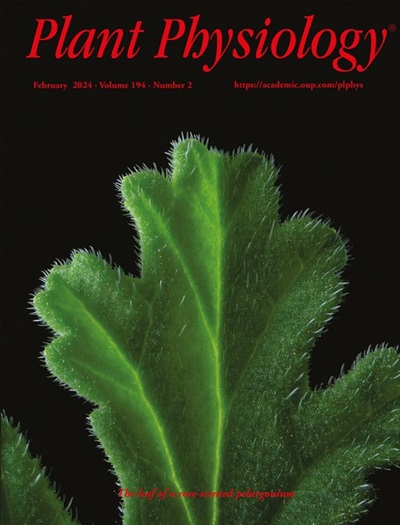解读拟南芥对亚致死联合和连续非生物胁迫的适应性
IF 6.9
1区 生物学
Q1 PLANT SCIENCES
引用次数: 0
摘要
植物经常面临环境挑战。植物对亚致死非生物胁迫组合的反应非常复杂,而且往往不同于对单个胁迫的反应,人们对这些反应仍然知之甚少。研究介导适应胁迫组合的性状和分子因素对于开发具有气候变化适应能力的大田作物至关重要。在此,我们研究了拟南芥对以下两种胁迫的形态、生理和分子反应:①同时出现的高温和干旱;②先涝后旱(这两种胁迫因气候变化而出现的频率增加);以及高温、干旱和涝等单个胁迫。在单一胁迫和综合胁迫下,对一组 15 个生理和形态特征进行了评估。通过将这些综合性状分析与转录组特征分析相结合,我们确定了与相应的单个胁迫相比,同时或连续的胁迫对植物形态和生理的影响通常是相加的负效应。虽然在两种胁迫组合中,干旱对各种生长、形态和生理性状的影响都很轻微,但在同时与高温或连续与水淹组合时,却出现了独特的转录组特征。经鉴定,多胁迫恢复能力的重要分子过程包括质体-细胞核交流、ABA 信号转导和光适应。根据 RNA-seq 数据,一组 39 个基因被确定为潜在的多重胁迫响应调节因子。我们对突变体进行了测试,以验证这些基因在联合胁迫下对植物存活和表型适应的贡献。我们证实了多个基因参与了表型适应性状的调控。在已确定的因子中,早花6(ELF6)和ARABIDOPSIS TÓXICOS EN LEVADURA 80(ATL80)分别对高温干旱和淹没后干旱期间的植物生长、叶片发育和植物存活(萎蔫)有重大影响。本文章由计算机程序翻译,如有差异,请以英文原文为准。
Deciphering Acclimation to Sublethal Combined and Sequential Abiotic Stresses in Arabidopsis thaliana
Plants are frequently exposed to environmental challenges. Responses to sub-lethal abiotic stress combinations are complex and often distinct from responses to individual stresses and remain poorly understood. Investigating traits and molecular factors mediating acclimation to stress combinations is essential for the development of climate change-resilient field crops. Here, we studied the morphological, physiological, and molecular responses of Arabidopsis thaliana to i) co-occurring high temperature and drought and ii) flooding followed by drought, both of which have increased in frequency due to climate change, and the individual component stresses: high temperature, drought and flooding. A set of 15 physiological and morphological traits were assessed during single and combined stresses. By combining these comprehensive trait analyses with transcriptome characterization, we established the generally additive negative effects of simultaneous or sequential stresses on plant morphology and physiology compared to the corresponding individual stresses. Although drought had a mild effect on various growth, morphological and physiological traits in both stress combinations, a unique transcriptome signature emerged upon combination with high temperature simultaneously or flooding sequentially. Molecular processes identified as important for multi-stress resilience included plastid-nucleus communication, ABA signaling and photo-acclimation. Based on the RNA-seq data, a set of 39 genes was identified as potential multi-stress response regulators. Mutants were tested to validate the contribution of these genes to plant survival and phenotypic acclimation under combined stress. We confirmed the involvement of several genes in regulating phenotypic acclimation traits. Among the identified factors were EARLY FLOWERING 6 (ELF6) and ARABIDOPSIS TÓXICOS EN LEVADURA 80 (ATL80), with substantial effects on plant growth, leaf development and plant survival (wilting) during high-temperature drought and post-submergence drought, respectively.
求助全文
通过发布文献求助,成功后即可免费获取论文全文。
去求助
来源期刊

Plant Physiology
生物-植物科学
CiteScore
12.20
自引率
5.40%
发文量
535
审稿时长
2.3 months
期刊介绍:
Plant Physiology® is a distinguished and highly respected journal with a rich history dating back to its establishment in 1926. It stands as a leading international publication in the field of plant biology, covering a comprehensive range of topics from the molecular and structural aspects of plant life to systems biology and ecophysiology. Recognized as the most highly cited journal in plant sciences, Plant Physiology® is a testament to its commitment to excellence and the dissemination of groundbreaking research.
As the official publication of the American Society of Plant Biologists, Plant Physiology® upholds rigorous peer-review standards, ensuring that the scientific community receives the highest quality research. The journal releases 12 issues annually, providing a steady stream of new findings and insights to its readership.
 求助内容:
求助内容: 应助结果提醒方式:
应助结果提醒方式:


